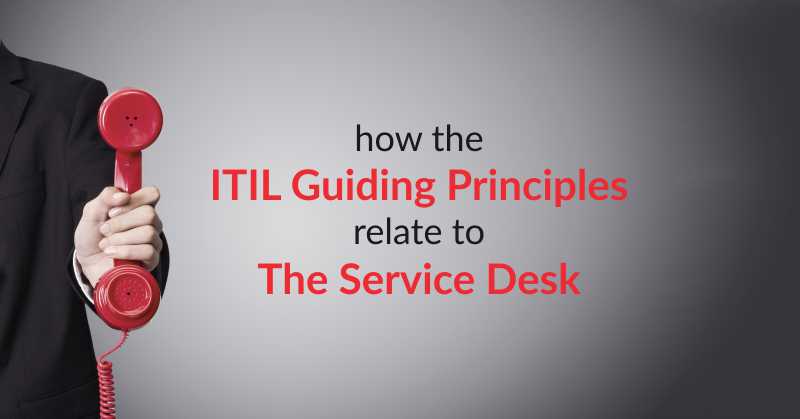
Announced on 13th March 2015 and launched on the 1st of February 2016, ITIL Practitioner has been touted as the most significant evolution in the 20 year history of the ITIL best practice framework.
The course from Axelos seeks to equip IT Service Management (ITSM) professionals with skills to successfully adopt and adapt ITIL to improve service management capabilities – organizational change management, communication, metrics and measurement – in line with business goals. One of the key highlights of the new offering are nine guiding principles which distill the core messages of ITIL specifically and ITSM in general, facilitating improvement activities of all types and at all levels. They outline the “how” that can guide organizations in their work as they adopt a service management approach and adapt the guidance provided in the ITIL publications to their own specific needs and circumstances.
So how do these principles relate with how the Service Desk works? Well, we already know that the Service Desk is the central hub of communication between any IT service provider and their internal or external customers. With this in mind, it is crucial that service desk staff display an innate understanding of the ITIL Guiding Principles and how they relate with delivering the best value for the customers and the business from the service desk perspective. Let’s see how this might look like by considering how to apply the nine principles in the service desk.
Focus on Value
It is important for any IT organization to realize that they do not just provide technology i.e. hardware and software, but more importantly solutions that enable the customer to attain their goals. Hence setting up a Service Desk has to have value at the top of mind. When a customer or user contacts the service desk, the agent has to see the value from the customer’s perspective in dealing with their service request, query or issue. If this is not done, then the customer will always see the service desk as a hindrance rather than a support towards meeting their objectives.
Design for Experience
Customer experience is defined as the entirety of the interactions a customer has with a company and its product. Hence it is important that when a service desk is set up, it should be considered how it contributes to a positive experience for the users and customers who interact with its staff members. So whether it is the service desk portal, phone etiquette training or processes that work to give the users the most efficient and friendly service, any service desk worth its salt must invest in each and every touch-point where the customer interacts with it to give the best experience.
Start where you are
This principle implies that IT organizations should resist the temptation to start from scratch and build something new without considering what is already available to be leveraged. This is important when driving any initiative in an organization, where there is more interest in spending money on new things rather that choosing the more efficient way of improving what exists. And this goes for the service desk, where changes to the existing processes, technology and people should be handled with care due to the direct impact they have on existing customers. Reinforcing what is working, improving what has potential, and eliminating only what truly does not fit with the desired new state will allow more iterative improvement, reduce resistance to change and reduce waste as the new state is achieved.
Work Holistically
No service, process, department or supplier stands alone. Everything is integrated and works together to ensure success or failure. So if we consider that the service desk is fine, but we have a poorly set up configuration management system or a dysfunctional problem management process, sooner or later those effects will trickle down to impacting the service desk and its image negatively. The results delivered to the customer will suffer unless the service provider works on the whole, not just on the parts. So any change to the service desk or to the IT organization has to be considered in its entirety, with regard to its impact on the 4 P’s (Product, Process, People and Partners).
Progress Iteratively
By organizing work into smaller, manageable sections that can be executed and completed in a timely manner, the focus on each smaller improvement is sharper and easier to maintain. Working in an agile manner, improvements to the Service Desk should be done in such a way that they build up on existing capability without introducing too much instability during the change. The purpose of iteration is to accomplish something that is of value. So value has to be focused upon to ensure that any improvement (no matter how smalls) to the service desk will directly result in positive impact to the customer.
Observe Directly
To know what is really going on, measure and/or observe it directly. Observing directly means actually going to the place where value-creating activity is occurring in the organization and seeing what really happens. So do we know how our Service Desks handle calls from users? It is important to not only consider highly processed and refined management reports, but also take time to sit and listen in to the actual calls and get a real feel on the ground. This provides proper grounds for making relevant changes to the operations on the Service Desk to meet the needs of the customers.
Be Transparent
Transparency is all about being clear, upfront and open about the goings on in an organization. And the same applies to the Service Desk. Each staff member should be made aware of their impact on the team, organization and customers. Any good service desk manager should keep their team updated on what impacts them, whether it be changes from above or improvements driven by customer needs. If more people are aware of what is happening, how it is happening and why it is happening, more people will help and fewer people will obstruct.
Collaborate
When the right people are involved in the right ways, improvements benefit from better buy-in, better relevance and better likelihood of long-term success. It is important to drive collaboration straight from the get go between service desk team members, and then with other members of the service desk organization. Functional escalations from the service desk to second and third line support teams only work well when all the parties work together towards a common goal. Team building activities can help build harmony among service desk members and the members of the IT organization who they work with which can only lead to better value for the customers.
Keep it Simple
This principle implies that in a process or procedure, use the minimum number of steps needed to accomplish the objective(s).If a process, service, action, metric, etc. provides no value or produces no useful outcome, then eliminate it. This sounds easy but at times, members of an IT organization are keen on introducing complexity for no good reason other than to look intelligent. And this applies to service desk who interact a lot with none IT savvy users so complexity is used to create hurdles that justify the existence of IT or simply resist change which is inevitable. It is important to ensure that the service desk team simplifies its processes for the good of the customer and the organization.
Read: Simplicity at the IT Service Desk
In summary, the nine principles state what is common sense i.e. how the Service Desk should be run and improved in order to meet the needs of the organization and its customers.
Vision Helpdesk: Simplify Your Life
signup for 30 days free trial.. no credit card. no obligation

Join the conversation